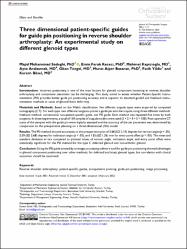Three dimensional patient-specific guides for guide pin positioning in reverse shoulder arthroplasty: An experimental study on different glenoid types

Göster/
Erişim
info:eu-repo/semantics/openAccessTarih
2022Yazar
Sadeghi, Majid MohammadKeçeci, Emin Faruk
Kapıcıoğlu, Mehmet
Aralaşmak, Ayşe
Tezgel, Okan
Başaran, Murat Alper
Yıldız, Fatih
Bilsel, Kerem
Üst veri
Tüm öğe kaydını gösterÖzet
Abstract
Introduction: Incorrect positioning is one of the main factors for glenoid component loosening in reverse shoulder
arthroplasty and component placement can be challenging. This study aimed to assess whether Patient-Specific Instrumentation (PSI) provides better guide pin positioning accuracy and is superior to standard guided and freehand instrumentation methods in cases of glenoid bone deformity.
Materials and Methods: Based on the Walch classification, five different scapula types were acquired by computed
tomography (CT). For each type, two different surgeons placed a guide pin into the scapula using three different methods:
freehand method, conventional non-patient-specific guide, and PSI guide. Each method was repeated five times by both
surgeons. In these experiments, a total of 150 samples of scapula models were used (5 × 2 × 3 × 5 = 150). Post-operative CT
scans of the samples with the guide pin were digitally assessed and the accuracy of the pin placement was determined by
comparison to the preoperative planning on a three-dimensional (3D) model.
Results: The PSI method showed accuracies to the preoperative plan of 2.68 (SD 2.10) degrees for version angle (p < .05),
2.59 (SD 2.68) degrees for inclination angle (p < .05), and 1.55 (SD 1.26) mm for entry point offset (p < .05). The mean and
standard deviation errors compared to planned values of version angle, inclination angle, and entry point offset were
statistically significant for the PSI method for the type C defected glenoid and non-arthritic glenoid.
Conclusion: Using the PSI guide created by an image processing software tool for guide pin positioning showed advantages
in glenoid component positioning over other methods, for defected and intact glenoid types, but correlation with clinical
outcomes should be examined.
Kaynak
Journal of Orthopaedic SurgeryCilt
30Sayı
1Bağlantı
https://hdl.handle.net/20.500.12868/1532https://journals.sagepub.com/doi/10.1177/10225536221079432

















